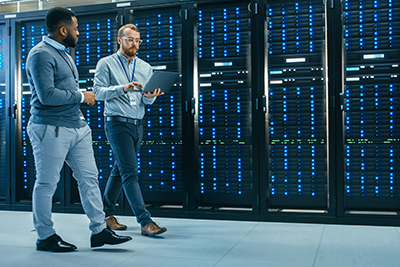
For a machine vision system to perform an accurate analysis, it needs to be trained with a huge amount of image data. In the quest to make a machine vision system as effective as possible, local storage and computing power become the bottleneck. As their data requirements and requests increase, companies are flocking to cloud computing.
Machine Vision Helps Automation Make Decisions
Industries have been using machine vision for decades now. With the combination of a camera and complex algorithms, machine vision can capture an image, analyze it, and interpret a course of action. Machine vision systems then pass that decision onto a form of automated equipment. Whether a robot or some other equipment, automated systems are granted the sense of sight.
Cloud Computing Takes Processing Power Outside of the Box
Building a local computer network is no easy task. Since budgets and space are limited, companies must find a balance between flexibility, storage, easy access, scalability, and security. Before the internet and wide area networks, all computing had to take place onsite. And until recent years, data speed limited how much processing could occur elsewhere. Not too long ago, it was faster to ship large amounts of data than to transmit it.
With internet speeds of 1 Gbps or more becoming common, cloud computing is now a viable solution for even more applications, including machine vision. Storage space, servers, databases, applications, and analytics can be accessed in real-time. Datacenters with seemingly unlimited storage and processing power give machine vision systems access to the image data they need to make the right decision every time.
Machine Vision Pros Explore the Benefits of Cloud Computing
When upgrading their machine vision systems, many companies realize they don’t have the bandwidth they need to make real-time machine vision decisions. Cloud computing lets machine vision integrators add hundreds of thousands of images to a dataset. By making use of server farms dedicated to deep learning, an analysis can be completed in an instant.
Cloud computing also allows for scalability that isn’t possible on the local level. Some industries see demand go up and down for various reasons, including seasonality. Instead of paying to maintain a network designed for peak demand, machine vision users can scale down the resources they need during times when they don’t need the processing power.
Practical Applications for Machine Vision and Cloud Computing
Pairing machine vision with cloud computing has created new possibilities. Grocery store chains are now using machine vision cameras to bill customers for the items they purchase. Cloud computing even makes it possible to analyze when a customer picks up or puts an item back on the shelf.
Always-connected self-driving cars pull real-time data to maneuver through road construction, yield to emergency vehicles, and even slow or stop for pedestrians. The computing power needed for self-driving cars extends behind a moving vehicle. More applications ranging from healthcare to agriculture to banking will continue to be enhanced by cloud computing.
Get the newest, most advanced machine vision cameras from the experts at Phase 1 Technology Corp.
